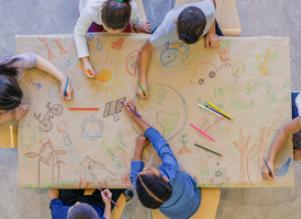11/24/2019
How Can We Help Foster Greta Thunberg's Drive in All Students?
In 2019, Swedish teenager Greta Thunberg captured the world’s attention with her eloquent environmental activism. But although Thunberg's fight against climate change certainly makes her stand out from the crowd, she is by no means the only youth activist out there. As noted in a CNN list of young environmental activists, Mari Copeny of Flint, Michigan, sent a letter about her city's water crisis to then-President Barack Obama in 2016 that was written powerfully enough to prompt Obama to fly to Flint and assess the situation personally. Arguably the most impressive part of the story is the fact that Mari was just 9 years old at the time.
Along with indigenous activists such as 14-year-old Autumn Peltier and 17-year-old Charitie Ropati, Thunberg and Copeny demonstrate both environmental activism and the power of effectively applied literacy skills. This ties into an important element of education and literacy instruction: student engagement.
According to the National Association of Independent Schools' 2016 guide to building student engagement, placing a greater emphasis on student motivation and engagement is “increasingly viewed as one of the keys to addressing problems such as low achievement, boredom and alienation, and high dropout rates.” So, what might this look like in practice? As a first step, NAIS researchers recommend examining the quality of the relationship between students and their “learning environment,” using factors such as the school’s approach to instruction and curriculum, the adults and peers in the students' lives, and the school community at large.
A post on the resource group All About Adolescent Literacy's website further connected the concept of student engagement to literacy by advising that, in addition to showing how reading and writing skills apply to real-world tasks, “teachers should also make literacy experiences more relevant to students' interests, everyday life, or important current events.”
With this in mind, here are some best practices to consider on the road to increasing student engagement.

Collaborate
Although California's Department of Education suggests students learn about climate change in relation to science standards, the inclusion of climate change in the curriculum is currently not mandated. Thus, teachers and students across the state are working together to advocate for climate change becoming a required topic—an effort of which Thunberg would surely approve.
A recent piece on the online resource site EdSource described the numerous creative and community-based efforts undertaken by an array of California school groups to learn about climate change in their state and develop local solutions. Of note, the EdSource article highlighted how students eager to apply essential literacy skills such as speaking, reading, and writing are working with teachers who feel passionate about the cause, which suggests teacher-student collaboration is a key ingredient in keeping students motivated and excited about school.
Connect
Echoing the NAIS guide's statement that relationships are at the root of student engagement, the All About Adolescent Literacy website made the point that “for many students, having a personal connection with at least one teacher can make a difference in their response to school.”
This is especially true for students who struggle with reading. Teachers looking to drive greater engagement and effort among such students can work to build lessons around the students’ interests, which has an added benefit of strengthening student-teacher relationships.
Indeed, in a post published on a website devoted to student agency, University of Pittsburgh education professor Jennifer Friedricks shared qualitative data gathered from interviews with students who talked about feeling “supported, cared for, and included by their teacher.” Perhaps unsurprisingly, the data revealed that students facing challenges—be these emotional, academic, behavioral, or otherwise—stand to gain the most from feeling connected at school, which can in turn boost their ability to acquire life-changing literacy skills.
Engage
In addition to building lessons around students' interests and deploying other classroom-based tactics, it is advisable to advocate for literacy instruction beyond the language arts or special education classroom. To help all students connect deeply with academic content—as opposed to passively absorbing it or missing it altogether—educators must work to ensure that literacy skills are a priority across the board, with classrooms, schools, and districts aligned to foster a “safe, positive, and creative school climate and culture.”
Through collaboration, connection, and engagement, student motivation and engagement will surely flourish, and the next Greta Thunberg or Mari Copeny might just emerge.

